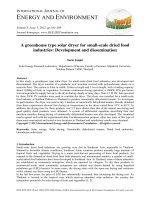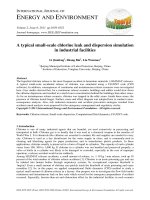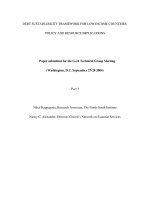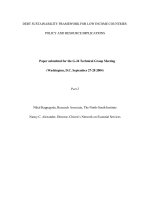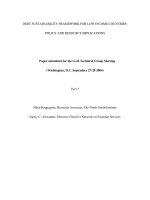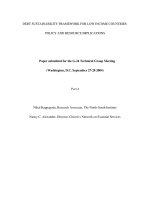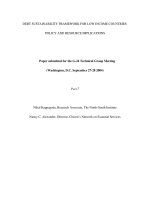Adaptive streaming framework for small scale remote monitoring and control applications
Bạn đang xem bản rút gọn của tài liệu. Xem và tải ngay bản đầy đủ của tài liệu tại đây (2.45 MB, 95 trang )
ADAPTIVE STREAMING FRAMEWORK FOR SMALL
SCALE REMOTE MONITORING AND CONTROL
APPLICATIONS
WU RONG
(B.Eng. (Hons.)), NUS
A THESIS SUBMITTED
FOR THE DEGREE OF MASTER OF
ENGINEERING
DEPARTMENT OF ELECTRICAL ENGINEERING
NATIONAL UNIVERSITY OF SINGAPORE
2013
2
3
Acknowledgement
I would like to express my special thanks to my supervisor Tan Kok Kiong who
gives the opportunity to work on this project and provides me with guidance and
helps throughout the research period. I have come to know much more on data
streaming system and various techniques in system optimization.
Secondly, I would also like to thank my research peers Kyaw Ko Ko Htet and
Arun Shankar Narayanan who helped me in carrying out tests of the system.
Lastly, a great thank you to National Instruments who provides me the hardware
and software for the research project.
4
Table of Contents
List of Tables 6
List of Figures 7
Summary 11
Chapter 1 Introduction 13
Chapter 2 System Overview 18
2.1 Hardware Setup 18
2.2 Software Setup 19
Chapter 3 Data Types Segregation and Prioritization 21
3.1 Parallel Data Streaming 22
3.2 Priority Streaming 31
3.3 Implementation in Real-Time Operation System 36
Chapter 4 Adaptive Video Streaming 41
4.1 Adaptation of Video Resolution Based on Network Speed 42
4.2 Adaptation of Frame Rate Based on Network Speed and Processor
Resources 47
4.3 Image Cropping 50
4.4 Performance of Different Video Codecs 54
4.5 Performance of Different Transport Protocols 60
Chapter 5 System Health Monitoring 62
5.1 System Heartbeat 62
5.2 System Resources Monitoring 67
Chapter 6 Remote Systems Synchronization 70
6.1 Setting up NTP Synchronization 73
6.2 Timestamp 74
Chapter 7 Applications of Framework 75
7.1 Ghost Driving 75
7.1.1 Multiple Data Types 80
7.1.2 Adaptive Video Streaming 85
5
7.1.3 System Health Monitoring 88
7.1.4 System Synchronization 89
7.2 Other Possible Applications 90
7.2.1 Refinery Plant Control 90
7.2.2 Telemedicine 90
Chapter 8 Conclusion 92
Reference 93
Author’s Publications 95
6
List of Tables
Table 4.1, Comparison of different video codecs 54
Table 4.2, Comparison of transfer speeds of TCP, UDP and Network Stream 61
Table 7.1, Data to be transferred between host computer and PXI 81
7
List of Figures
Figure 2.1, System setup with one host computer and one client computer, remote
access could be multiple devices 18
Figure 2.2, Software architecture of the framework 20
Figure 3.1, Sequential data transmission, system waits till all data ready and
transmit at once 24
Figure 3.2, Parallel data transmission, data is sent once it is ready without waiting
for other data types and further data processing 25
Figure 3.3, GUI of receiving end showing one image, 4 numeric and 1 Boolean
data 26
Figure 3.4, Benchmarking of transmitting data in sequence, average of 126.38 ms
to send over all data types with dissemination 27
Figure 3.5, Benchmarking of sending image in parallel with other data types,
average of 98.85 ms to send one image 28
Figure 3.6, Benchmarking of sending Boolean in parallel with other data types,
average of 2.18 ms to send one Boolean 28
Figure 3.7, CPU usage when sending data in sequence in Core 1 29
Figure 3.8, CPU usage when sending data in parallel making use of all cores 30
Figure 3.9, With same priority as other data types, Boolean takes average 2.18 ms
to transfer 32
Figure 3.10, With higher priority than other data types, Boolean takes average
0.10 ms to transfer 33
Figure 3.11, CPU usage when setting priority for Boolean with transmission
interval of 1 ms 34
Figure 3.12, CPU usage reduced to 16% when Boolean transmission interval is
increased to 5 ms 35
Figure 3.13, Time taken for each Boolean value to be transmitted over still
maintains at 0.11 ms 35
8
Figure 3.14, Average time taken for each Boolean value to be transmitted over is
1.36 ms with a standard deviation of 5.41 ms when running in Windows 37
Figure 3.15, Average time taken for each Boolean value to be transmitted over is
1.01 ms with a standard deviation of 0.09 ms when running in RTOS 38
Figure 3.16, System setup of RTOS remote access 39
Figure 3.17, iPad GUI with data updated according to Network Shared Variables-
40
Figure 4.1, Test system setup, a web camera is connected to a PC through USB
cable 43
Figure 4.2, Average time to take an image from a camera with resolution change
in camera is 105 ms 44
Figure 4.3, Average time taken to re-configure the camera to take video with a
different resolution is 310 ms 44
Figure 4.4, Average time taken to acquire one image and change its resolution in
software is 119.03 ms 45
Figure 4.5, CPU usage when resolution change is done in camera is 12 %.
Memory usage when resolution change is done in camera is 2.35 GB 46
Figure 4.6, CPU usage when resolution change is done in software is 18 %.
Memory usage when resolution change is done in camera is 2.40 GB 47
Figure 4.7, Flowchart of implementing frame rate control 50
Figure 4.8, Image cropping GUI in LabVIEW 51
Figure 4.9, Flowchart of implementing image cropping in host computer 52
Figure 4.10, Flowchart of the remote computer when it receives a command from
the host to crop image 53
Figure 4.11, Comparison of video codecs 55
Figure 4.12, A typical sequence with I-, B- and P-frames [13] 56
9
Figure 4.13, With difference coding, only I-frame is coded fully. In the following
P-frames, only the running man is coded in motion vectors, the house is not coded
[13] 56
Figure 4.14, JPEG compressed image with 100% quality has 28.91% of the
original data size 58
Figure 4.15, Image of 100% quality JPEG compression 58
Figure 4.16, JPEG compressed image with 50% quality has 3.92% of the original
data size 59
Figure 4.17, Image of 50% quality JPEG compression 59
Figure 4.18, Comparison of transfer speeds of TCP, UDP and Network Stream
61
Figure 5.1, Starting another resource demanding program in the remote target
caused one missing heartbeat pulse when heartbeat is implemented in application
layer 63
Figure 5.2, Starting another resource demanding program in the remote target
does not cause any delay in heartbeat pulse when heartbeat is implemented with
dedicated thread and communication port 64
Figure 5.3, LabVIEW GUI of receiving heartbeat with measure of heartbeat
frequency 66
Figure 5.4, Heartbeat frequency changed when user sets a different maximum
heartbeat frequency 66
Figure 5.5, Heartbeat Stop warning when the remote site is forced to stop 67
Figure 5.6, LabVIEW GUI of detecting remote system CPUs and monitoring of
CPU usage 68
Figure 5.7, The program also monitors memory usage and hard drive space 68
Figure 5.8, LabVIEW GUI of remote board temperature monitoring 69
Figure 5.9, LabVIEW GUI of warning message showing board overheated 69
Figure 6.1, Architecture of a GPS synchronized system 71
10
Figure 6.2, A typical system setup of NTP synchronization 72
Figure 6.3, NTP synchronization 73
Figure 7.1, System architecture of electric car remote driving 76
Figure 7.2, The electric car where the framework is tested in 77
Figure 7.3, Interior of the electric car, motors are used to control steering 77
Figure 7.4, Remote driving kit that has USB interface 78
Figure 7.5, LabVIEW GUI of host computer, System Data Tab 78
Figure 7.6, LabVIEW GUI of host computer, System Health Tab 79
Figure 7.7, LabVIEW GUI of electric car, System Data Tab 79
Figure 7.8, LabVIEW GUI of electric car, System Health Tab 80
Figure 7.9, Car Control information is at top priority, it takes less than 1 ms to
transmit over 82
Figure 7.10, Car Info is at second priority, it takes less than 10 ms to transmit
over 83
Figure 7.11, The longitude and latitude information is mapped on Google Map
with map format “mobile” and zoom level of 17 84
Figure 7.12, Google map with map format of “terrain” and zoom level 16 85
Figure 7.13, GUI portion that displays two videos and an obstacle map from
LIDAR readings 86
Figure 7.14, LabVIEW pop up window for image cropping 87
Figure 7.15, Only the cropped portion is then sent over 87
Figure 7.16, GUI portion that displays resources monitoring and heartbeats 88
Figure 7.17, Heartbeat Stop alarm triggered when remote site is forced to shut
down 89
11
Summary
This project provides a framework for small scale remote monitoring and control
systems which do not have their own communication infrastructures, and depend
heavily on public networks. The limitation lies on the bandwidth and stability of
the network. Existing frameworks and standards are mostly designed for big scale
systems such as Supervisory Control And Data Acquisition (SCADA) systems.
This framework aims to address the challenges in small remote systems. It can be
deployed to both Windows operating system and real-time operating system, as
often remote control systems require time deterministic controls.
There are a few challenges of facilitating communication in such small remote
systems. Firstly, performance depends solely on available networks that are
usually shared among many users. When available network bandwidth for the
program is not stable, data may be delayed or lost. Secondly, there are many
different data types to be transferred between the remote station and the host
computer at different frequencies. Thirdly, when a system is deployed remotely,
there must be a way to check its conditions for maintenance purposes.
The framework created addresses the above problems.
Parallel communications using different transmission protocols are implemented
so that multiple data types can be transmitted at different frequencies with
different priority levels. Instead of the common practice of converting all data to a
string and sending as a data packet, each data type is sent as it is with a dedicated
communication port. Parallel programming technique is used to assign the
communication ports to separate threads for parallel processing so as to fully
utilize CPU resources and network bandwidth. In this way, different data types
can be sent at different frequencies. Each data type is assigned with a priority
12
level so that critical data can be sent timely. This is achieved by pausing lower
priority level tasks to free up enough resources for critical data; CPU re-
scheduling is required.
Adaptive video streaming is employed to ensure smooth communication when
network bandwidth varies. Video usually takes up much of bandwidth. In this
framework, video frame rate is auto-adjusted according to network speed, user
options are available for different resolution level, allowing cropping of image
also reduces the amount of data significantly. Performance of common
compression schemes and communication protocols are compared and evaluated.
Synchronization of the host and remote stations allows user to tell timeliness of
the data. Obsolete data should not be used for critical decision making. Network
Time Protocol (NTP) technique is employed to synchronize the host and remote
systems. The host computer is configured to be the time server, remote system
runs NTP synchronization algorithm once per 30 minutes.
Lastly, implementation of system heartbeat and system condition monitoring
addresses system maintenance problems. Heartbeat is important for remote
systems especially headless systems to make sure that the program is running.
Information such as CPU or memory usage or overheating of hardware is used for
predictive system maintenance to avoid unnecessary system break down.
This framework is tested in a remote electric car driving project, and results are
presented.
13
1. Introduction
Remote monitoring and control refers to the measurement of disparate
devices from a network operations center or control room and the ability
to change the operation of these devices from that central office [1]. In
simple terms, a remote monitoring and control system is a system in which
the control center is able to access and change the operations of some
devices that are deployed some distance from the control center. In order
to access and change those remotely deployed devices, data must be
exchanged between the control center and the remote devices.
The most famous application of remote monitoring and control is
Supervisory Control And Data Acquisition (SCADA) system. A SCADA
system is usually deployed in large scale that involves many subsystems
including its own communication infrastructure with industrial
communication buses and protocols [2]. The data streaming technology in
SCADA industry is quite well established and network bandwidth is
seldom a concern as it has its own communication infrastructure. For
example, Foundational Field Bus is commonly used in Oil & Gas industry,
ModBus is used in some Programmable Logic Controllers (PLCs).
Example applications of SCADA systems are smart grid, water treatment
or structural health monitoring.
With increasing accessibility and stability of commercial networks and
wireless technologies, there are increasing demands on remote monitoring
and control systems, be it on a large deployment or small scale. Although
communication technology is well established in big remote control and
monitoring systems, it is still quite new for small scale applications. Data
streaming for small systems relies heavily on commercially available
networks as they usually do not have their own communication
14
infrastructure. There are some works done in this field to make use of
commercial networks for data exchange, for example, sending SMS alarm
to an operator through GSM, or adaptive video streaming that works under
low internet speed [3].
Adaptive streaming technology is by far optimized for video streaming
and focuses on the delivery of good video quality. Main adaptive
streaming technology adopted by vendors and service providers include
Adobe with Flash-based Dynamic Streaming, Apple with HTTP Live
Streaming (HLS), and Microsoft with Smooth Streaming for SilverLight
[8]. However, a control system usual requires more than one type of data,
for example, some numbers to indicate the current status of the system,
Booleans to tell the operator whether there is an alarm, and probably
videos for environment inspection. There are few available platforms in
the market that can cater to streaming of different types of data for small
scale remote monitoring and control systems. Most of the existing
platforms either cater to only one particular data type, like video, or
convert all data types to a string and send as a data packet. In the second
method, all data types are treated with equality, it may cause delay in
sending critical information.
In this thesis, a framework of adaptive data streaming for small scale
remote monitoring and control systems is presented. The framework can
be deployed to both Windows Operating System and Real-Time Operating
Systems (RTOS). It is recommended that for control systems that require
very low latency and time deterministic tasks to use RTOS.
A data stream is a sequence of digitally encoded coherent data packets
which are in the process of being transmitted [4]. In high volume data
streaming, the available network bandwidth can be utilized close to
15
capacity and any variation in the line conditions can adversely affect the
data streaming performance. Thus, given the inevitable dynamics both in
the line conditions and data transfers happening, adaptive data streaming
is required for the transmission of large amount of data effectively over a
network. With adaptation, when the connection is good, the client receives
a high-quality and high-data-rate stream. When the connection speed
drops, the client will compromise with a lower quality and/or, lower rate
transfer to maintain a continuous connection. Such abilities to attain
required system performance with intelligent adaptation have led to the
implementation of new industrial control configurations based on wireless
area networks [5] - [7].
Dynamic transmission along with an increasing number of devices
transmitting all at once over the same wireless bandwidth leads to higher
and faster variation in transmission rate with time, opening up challenges
in the implementation of real-time wireless communications in control
and monitoring applications. In monitoring and control industrial
applications, multiple data types will be circulating within the application
and may be associated with different priority level at a point in time. Thus,
the framework must be able to address these challenges.
A key challenge is the capability to prioritize transmission of different
types of data of concern in the application over a limited bandwidth.
Generally, control systems require transfer of multiple data types bi-
directionally and transfer in real-time in order to allow critical decision
making. A common approach is to convert all data to string, or pack them
into a cluster, before transferring these clusters in series. The limitation
with this approach is the lack of flexibility to prioritize certain data types
over others, and to transmit high priority data types more accurately and in
a timelier manner so that critical information is received in an expedient
16
manner even when the bandwidth is limited. The proposed framework
allows the streaming of different data types in parallel channels and
allowing a priority level to be assigned to these channels.
Another challenge specifically relates to the transmission of high volume
density data such as real-time surveillance videos over a network of
limited bandwidth. The adequacy of video streaming hinges on the
requirements at the receiving end which can be in terms of a frame rate,
resolution or a weighted variation of these uncompromising requirements.
Adaptive video streaming approaches can seek the optimal balance point
among these parameters, adapting to different network speeds, and at the
same time, allow enough quality for the viewer to make necessary
decisions. Thus, instead of focusing on pushing video quality [6]-[8], the
available bandwidth can be used as the overriding factor to allow users to
choose what is more important for viewing. For example, video quality
may be traded-off for frame rate when fast update of the images is
important, or allowing cropping of part of the image to have a better focus
on a small area, reducing video size and maintaining the image resolution
when close inspection of small parts is of interest. The proposed
framework allows video resolution and frame rate to be adapted based on
network speed and it includes functionalities to release capacity by
allowing user cropping of viewing window to remove unnecessary data
when an optimal and acceptable quality cannot be possible. The
performance of different video codec and transport protocols will also be
analyzed so an appropriate combination can be chosen for a specific
requirement.
System health monitoring is important for remote control systems. As the
actual control system is deployed distance away from the control center,
the operator needs some visibility of the system status to make decisions
17
for system maintenance and avoid unnecessary system break down or
over-worn of the machine. A system health monitoring subsystem is
integrated in the framework.
Finally, in a real-time application, the synchronization of host and client
systems is most critical to allow remote control and monitoring. Network
speed can affect the rate of data exchange between the host and client
systems significantly. Data received for decision making cannot be
received at a time too much later than the expected time as this will lead to
a loss of synchronization and therefore, mis-timed and incorrect final
actions carried out. The proposed framework utilizes Network Time
Protocol (NTP) synchronization in order to make sure that the data
received within an acceptable time threshold for the application.
This framework is tested in an electric car remote driving project, results
are presented.
The rest of the thesis is organized as follows. Chapter 2 introduces the
system architecture, including hardware and software used in the
framework. Chapter 3 explains how different data types are segregated
and transmitted in parallel with different priority levels. In chapter 4,
adaptive video streaming with various user options is presented. System
health monitoring is discussed in chapter 5. Chapter 6 briefly explains how
system synchronization is done. The performance of the framework is
tested in an electric car remote driving project and the results are presented
in chapter 7. Lastly, chapter 8 is a conclusion that briefly sums up this
thesis.
18
2. System Overview
System setup considered in this thesis is shown in Figure 2.1. The host
computer is connected to the client computer via a point to point
connection. At the same time, the host computer acts as a server, and it
allows remote access of data from other machines, such as smart phones
or tablets. The client computer has cameras and other measurement
sensors or actuators connected to it for substation control.
Figure 2.1, System setup with one host computer and one client computer, remote
access could be multiple devices
2.1 Hardware Setup
In the realization here, the client computer is a PXI system which is a
modular, PC-based platform for test, measurement and control. The
PXI runs Windows 7 and can be formatted to run Real-Time-
Operating-System (RTOS). The PXI system can be used to realize
different types of monitoring and control applications. For
19
generalization, the framework is also tested with the PXI running
Windows 7 and another PXI running RTOS to prove that this
framework can work in both Windows and RTOS environment. The
host computer is a laptop running Windows 7. They are connected
under the same network, and can communicate with each other
through Transmission Control Protocol (TCP), User Datagram
Protocol (UDP) and Network Stream (NS). The remote access device
can be a computer or a tablet like an iPad. At the client computer side,
two webcams are used for video acquisition.
2.2 Software Setup
The programming platform used is LabVIEW and it is chosen because
it can be deployed to all the three systems, thus eliminating the needs
to program different platforms using different programming languages
and create interfaces for the different programs which usually
introduce unnecessary latency.
Figure 2.2 shows simplified software architecture of the framework.
Three main tasks are running independently, including parallel data
transmitting and receiving, system clock synchronization and system
health monitoring. Details of implementing each task will be discussed
in the later chapters.
20
Figure 2.2, Software architecture of the framework
21
3. Data Types Segregation and Prioritization
Control and monitoring applications will typically require multiple and
different data types to be transferred instantaneously and since
“instantaneously” is an unachievable notion with practical constraints in
the network, prioritization with their transfers is important. For example,
in the remote monitoring of a refinery plant, numerical data types exist to
relate to parameters such as temperature and oxygen contents, and string
types are needed for alarm messages. Apart from them, videos are also
required during site inspections. From the control center, commands are
sent to the plant such as Boolean commands to shut down or start up a
system.
The common way to incorporate different data types is to convert all data
to a string or pack them into a cluster, and then transferring a single string
or series of clusters through the network. However, the problems with
such an approach are all data types are treated as with same level of
importance and processing time to disseminate the data packet. When the
network speed is low, receiving time critical information becomes an issue
because available bandwidth is shared between the critical information
and non-critical information, and they are all queued within the series of
clusters. For example, an alarm message cannot be received once an alarm
is triggered as the alarm message is queuing up together with other
information and data types which are not sent yet and allocated ahead of
the alarm. To resolve this problem, it is desirable for the framework to be
able to segregate and prioritize different data types cleanly and in a
parallel manner.
22
3.1 Parallel Data Streaming
Making use of the multi-cores in a processor as well as using more
bandwidth in the network would help to increase data processing and
streaming speed greatly. As the speed of processors increases to a
limit, vendors of processors had come out with a solution to overcome
this problem; that is to increase the number of cores and divide a
bigger task into small tasks and process the smaller tasks in different
cores simultaneously. To tack on the advantage of a multi-core
processor, parallel programming is needed. A network is usually
shared by many users. To make greater use of the bandwidth, we can
configure multiple virtual communication ports in one computer. After
comparing the performances of sending data sequentially and
parallelly, this framework chooses to use parallel data streaming.
Usual communication protocols used in network streaming are
Transmission Control Protocol (TCP) and User Datagram Protocol
(UDP). TCP provides reliable, ordered, error-checked delivery of a
stream of octets between programs running on computers connected to
an intranet or the public internet [9]. UDP uses a simple transmission
model with a minimum of protocol mechanism [10]. TCP is useful for
lossless communications and UDP is more for applications that do not
require reliability of data, but instead emphasize on low-overhead
operation and reduced latency rather than error checking and delivery
validation.
TCP treats data to be transmitted as just an unstructured stream of
bytes, and this has some important implications on how it is used. One
aspect of this characteristic is that since TCP does not understand the
content of the data it sends, it normally treats all the data types in a
23
stream as equals. The data is sent to TCP in a particular sequence, and
is transmitted in that same order.
On the other hand, UDP sends the most current data out; however, it
does not guarantee that the data is received. Therefore, critical
information cannot be sent using UDP.
Using TCP or UDP alone will not meet the data requirements of a
remote control system. TCP guarantees lossless communication, but
important data are not sent timely. UDP provides a faster way of
communication, but it is lossy, important data may be lost if network
connection is not stable.
In order to be able to segregate different data types, the data should
not be packed together, and sent in sequence. To achieve this, different
data types should be sent independently in parallel.
To send data in parallel, each data type should have its own
communication port. A communication port is an application-specific
or process-specific software construct serving as a communications
endpoint in a computer’s host operating system [11]. As it is a
software construct and not a physical channel, more than one port can
be configured in a computer. Each port will be assigned a unique port
number in the host computer. Configuring different ports also enables
network streaming using different protocols at the same time. For
example, use TCP to transfer important data like an alarm message,
and UDP to transfer data that allows some lossy information but need
to be sent timely like temperature reading of a machine.
24
Figure 3.1 illustrates typical situations in sending data sequentially.
Time axis is not drawn to scale. If one data stream contains one image
data, one numeric data and one Boolean data, the system waits till all
three data types are ready to be send, and change all data types to a
string and package them together in a pre-defined order. Then the data
stream is transmitted through network. The receiving system receives
the whole data package, separate the data according to the pre-defined
order, and convert them back to the original data types.
Figure 3.1, Sequential data transmission, system waits till all data ready and
transmit at once
Figure 3.2 illustrates the situation when different data types are sent in
parallel. Time axis is not drawn to scale. In a system that is running in
parallel, when some data is ready to be sent, it can be sent
immediately, need not to wait for other data. Before sending the data,
no data packaging is needed. At the receiving end, the data is not
needed to be unpacked. The time taken to transfer all three data types
is less as no data processing is needed. The latencies in sending the
numeric and Boolean are much smaller as these data can be sent
immediately when it is ready, need not to wait for the image to be
ready. In this way, if the numeric or Boolean data needs to be sent
more frequently than the image, it can easily be done.
25
Figure 3.2, Parallel data transmission, data is sent once it is ready without
waiting for other data types and further data processing
Experiments are done to investigate the performances of sending data
in sequence as compared to sending data in parallel.
Two programs are done to send the same data, including an image,
four numeric data, and a Boolean value. One program sends all the six
data using TCP with all data packaged in a sequence. The second
program sends all the six data in parallel using TCP through six
different ports. Only one type of protocol, TCP, is used throughout the
experiment to make sure that changes in performance is not caused by
different speeds of protocols. Figure 3.3 shows the Graphical User
Interface (GUI) of the receiving side of the programs.
